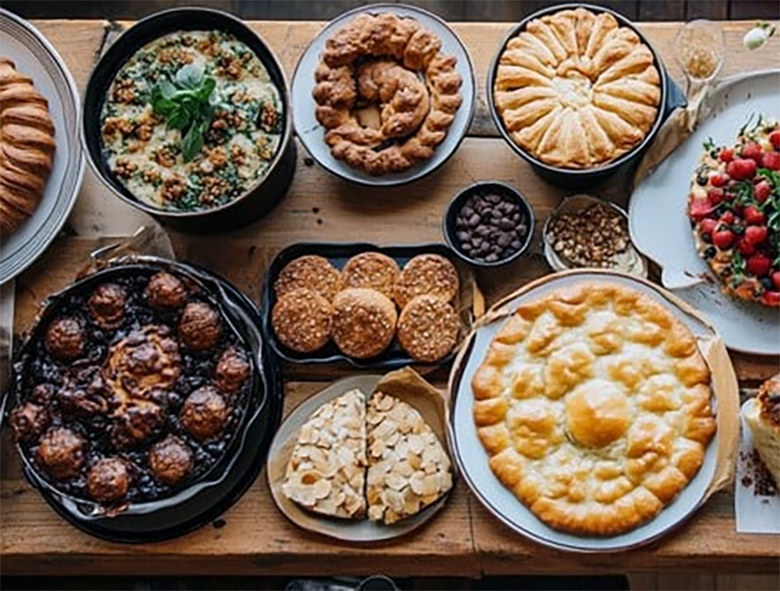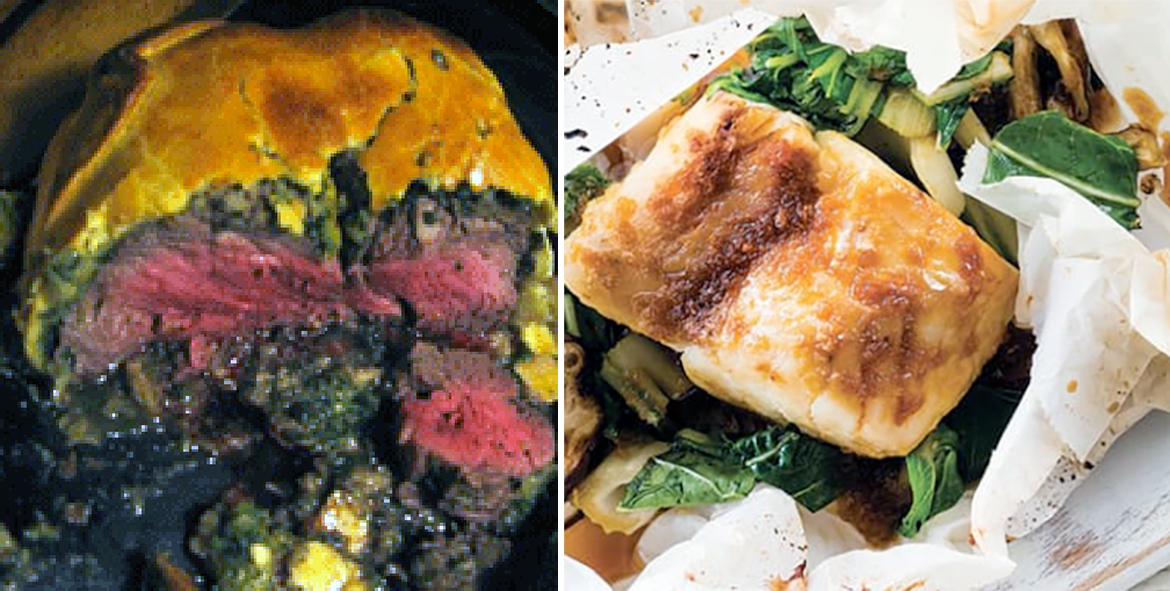FabulousFusionFood's Baking Recipes 9th Page
 A range of baked goods.
A range of baked goods.
Welcome to FabulousFusionFood's Baking Recipes Page — This is a continuation of an entire series of pages that will, I hope, allow my visitors to better navigate this site. As well as displaying recipes by name, country and region of origin I am now planning a whole series of pages where recipes can be located by meal type and main ingredient. This page gives a listing of all the baking recipes added to this site. Baking is defined as a technique for the prolonged cooking of food using dry heat by the action of conduction. Baking is normally done in an oven, but goods may also be baked in hot ashes or on hot stones. Baking differs from Roasting Recipes in that a lower temperature is typically used and the items are cooked for a longer period of time. Baking is a much older process than most people think and foods were probably originally baked in embers or with hot stones (which is how bread may have started). Only later did specialist ovens develop. Though most baked goods tend to be bread or cake-based some other dishes such as pasta dishes and vegetable dishes may also be baked. Stews are often also technically baked in an oven, but are not classed as 'baked goods' in that they are more liquid than solid at the end of the cooking process.
Baking is a method of preparing food that uses dry heat, typically in an oven, but can also be done in hot ashes, or on hot stones. The most common baked item is bread, but many other types of foods can be baked. Heat is gradually transferred "from the surface of cakes, biscuits and cookies, and pieces of bread to their centre, typically conducted at elevated temperatures surpassing 150°C. Dry heat cooking imparts a distinctive richness to foods through the processes of caramelization and surface browning. As heat travels through, it transforms batters and doughs into baked goods and more with a firm dry crust and a softer centre. Baking can be combined with grilling to produce a hybrid barbecue variant by using both methods simultaneously, or one after the other. Baking is related to barbecuing because the concept of the masonry oven is similar to that of a smoke pit.
In addition to bread, baking is used to prepare cakes, pastries, pies, tarts, quiches, biscuits and cookies, scones, crackers, pretzels, and more. These popular items are known collectively as 'baked goods', and are often sold at a bakery, which is a store that carries only baked goods, or at markets, grocery stores, farmers markets or through other venues.
 Beef en croûte (left) and fish en papillote (right).
Beef en croûte (left) and fish en papillote (right).
The alphabetical list of all the baking recipes on this site follows, (limited to 100 recipes per page). There are 2282 recipes in total:
Page 9 of 23
| Eog Wedi Crasu Gyda Bara Lawr â Chaws (Baked Salmon with Laver Bread and Cheese) Origin: Welsh | Fish Slice Origin: Britain | Fresh Pumpkin Pie Origin: American |
| Eog wedi ei Bobi gyda Thatws a Teim (Salmon Baked with Potatoes and Thyme) Origin: Welsh | Fish Terrine Origin: Britain | Friands aux Amandes (Mini Almond Cakes) Origin: France |
| Erbolat Origin: England | Flødekartofler (Scalloped Potatoes) Origin: Denmark | Fricassée de Lambi (Queen Conch Fricassee) Origin: Martinique |
| Eve's Pudding Origin: England | Flaky Pastry Origin: Britain | Frosted Family Mince Pie Origin: British |
| Eve's Pudding II Origin: Britain | Flampoyntes (Flan Points) Origin: England | Frosted Walnut Cake Origin: American |
| Excellent Small Cakes Origin: Britain | Flan Amande et d'abricot (Almond and Apricot Flan) Origin: France | Fruit Bonnag Origin: Manx |
| Fairy Cakes Origin: Britain | Flan Coco Antillais (French Antilles Coconut Flan) Origin: Saint-Martin | Fruit Shrewsbury Biscuits Origin: Britain |
| Fanouropita (Greek Spiced Sultana Cake) Origin: Greece | Flan Coco Antillais (French Antilles Coconut Flan) Origin: Saint Barthelemy | Fruit Sponge Cake Origin: Czech |
| Far Breton à la Cerise (Breton Far with Cherries) Origin: France | Flan Coco Antillais (French Antilles Coconut Flan) Origin: French Guiana | Fruited Luncheon Cake II Origin: British |
| Far breton aux pruneaux (Breton Far with Prunes) Origin: France | Flan Coco Antillais (French Antilles Coconut Flan) Origin: Guadeloupe | Fuchsia Berry Scones Origin: Britain |
| Farina Pie Origin: Bermuda | Flan Coco Antillais (French Antilles Coconut Flan) Origin: Martinique | Fuggan Origin: Britain |
| Fat Hen and Potato Gratin Origin: British | Flan Coco Antillais (French Antilles Coconut Flan) Origin: Sint Maarten | Funkaso (Millet Pancakes) Origin: Nigeria |
| Fat Hen Quiche Origin: British | Flaón Origin: Spain | Gâteau à L'Orange Origin: France |
| Fatayas Sénégalais (Senegalese Fatayas) Origin: Senegal | Flapjacks Origin: British | Gâteau au Coco (Coconut Cakes) Origin: Togo |
| Fedt Kager (Melting Moments) Origin: Denmark | Flaumpens Origin: England | Gâteau Caraque Origin: France |
| Feisty Cock Origin: Scotland | Florentine Pizza Origin: Italy | Gâteau de Savoie (Savoy Cake) Origin: France |
| Feuilles de Consoude Farcies (Stuffed Comfrey Leaves) Origin: France | Flourless Chocolate Cake Origin: British | Gâteau de Semoule aux Agrumes (Semolina and Citrus Cake) Origin: Mali |
| Fflan Cenin a Phys (Leek and Pea Flan) Origin: Welsh | Focaccia Barese Origin: Italy | Gâteau marbré chocolat poire (Marbled Chocolate Yoghurt Cake) Origin: France |
| Fiadone Origin: France | Focaccia with Rosemary Leaves and Olives Origin: Italy | Gâteau Mont Blanc Origin: France |
| Fig and Almond Cheesecake Origin: Britain | Fochabers Gingerbread Origin: Scotland | Gãteau à la Banane (Banana Cake) Origin: Togo |
| Fig and Honey Cupcakes Origin: Britain | Fondant baulois (Baule fondant) Origin: France | Galette des rois bretonne (Breton King Cake) Origin: France |
| Figgy 'Obbin Origin: England | Fonio Bread Origin: Fusion | Galette joinville (Joinville Pie) Origin: France |
| Figolli (Maltese Easter Biscuits) Origin: Malta | Foolproof Pie Crust Origin: American | Galettes Bretonnes Origin: France |
| Filets de Morue au Fromage (Cod Fillets with Cheese) Origin: Canada | For Flaunes (For Flans) Origin: England | Garaasa (Sudanese Flatbread) Origin: Sudan-a |
| Filipino Cassava Cake Origin: Philippines | For to make flampens (To Make Pasta Pies) Origin: England | Gari Biscuits Origin: Ghana |
| Filo/Phyllo Pastry Origin: Britain | Forfar Bridies Origin: Scotland | Garlic Naan Bread Origin: Burkina Faso |
| Finsk Brød (Finnish Bread) Origin: Denmark | Forfarshire Barley Meal Scones Origin: Scotland | Garlic Potatoes Origin: Ireland |
| Fir Cone Tartlets Origin: Britain | Forgotten Pudding Origin: Aruba | Gastris (Nut Cake) Origin: Roman |
| Fish Breyani Origin: South Africa | Fougasse de Monégasque (Monaco-style Fougasse) Origin: Monaco | Gateau Ayisyen (Haitian Cake) Origin: Haiti |
| Fish Creole Origin: Louisiana | Francatelli's Yorkshire Pudding Origin: Britain | Gateau Ayisyen Zoranj (Haitian Orange Cake) Origin: Haiti |
| Fish in Barley Bread Origin: Ancient | Frankfurter Kranz (Frankfurt Crown Cake) Origin: Germany | Gateau breton au crème de pruneaux (Breton cake with prune paste) Origin: France |
| Fish in Vine Leaves Origin: Greece | French Bread Origin: France | Gâteau breton traditionnel (Traditional Breton Cake) Origin: France |
| Fish Pie with Dulse Origin: Scotland | French Bread Pizza Origin: Italy | |
| Fish Serre Origin: Belize | Fresh Coconut Cake Origin: Aruba |
Page 9 of 23